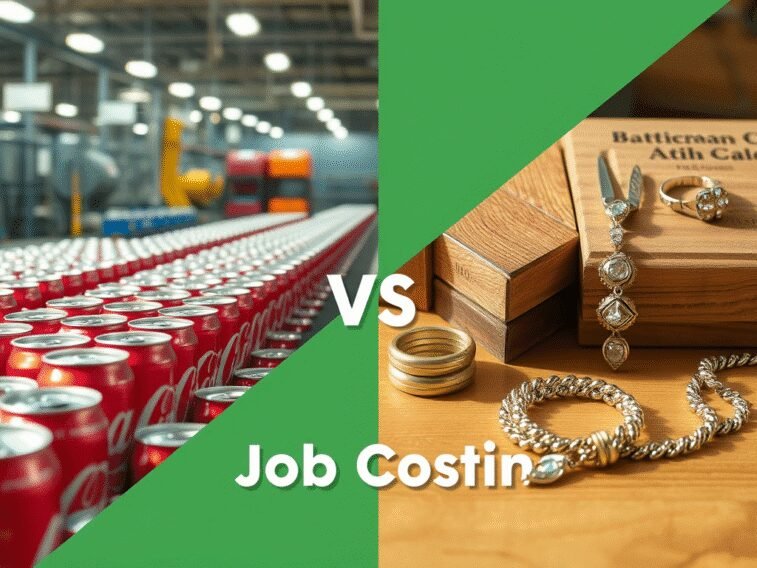Discover the key differences between process costing vs job costing in our comprehensive guide. Learn how each method applies to different production environments, their advantages, disadvantages, and how to choose the right one for your business needs.
Process Costing vs Job Costing: A Comprehensive Guide
In the world of accounting, costing methods are essential tools for determining the cost of producing goods or services. These methods help businesses track expenses, set prices, and evaluate profitability. Two widely used approaches are process costing and job costing, each tailored to different production environments. This article provides an in-depth look at both methods, exploring their definitions, applications, advantages, disadvantages, and key considerations for choosing between them.
What is Costing and Why Does It Matter?
Costing is the process of calculating the total expenses involved in production, including materials, labor, and overhead. Accurate costing enables businesses to:
- Determine the cost per unit or per project
- Set competitive prices
- Monitor and control expenses
- Assess financial performance
The choice of costing method depends on the nature of the business and its products. Let’s dive into the two main methods: process costing and job costing.
Understanding Process Costing
Process costing is designed for industries where production is continuous and products are identical or nearly identical. Think of factories churning out thousands of gallons of paint, bottles of soda, or yards of fabric. Costs are collected over a period—say, a month—and then averaged across all units produced.
How It Works
- Cost Accumulation: Costs are gathered by department or production stage (e.g., mixing, bottling, packaging).
- Averaging: Total costs are divided by the number of units to find the cost per unit.
- Key Industries: Chemical production, oil refining, food processing, and mass manufacturing.
Real-World Example
Imagine a factory producing 50,000 cans of soda in a month. The total cost—covering ingredients, labor, and machinery—is $100,000. Using process costing, the cost per can is $100,000 ÷ 50,000 = $2. This simplicity makes process costing efficient for high-volume, standardized production.
Understanding Job Costing
Job costing, or job order costing, is the go-to method when products or services are unique and produced in distinct batches or “jobs.” It’s perfect for custom work, where each project has its own specific requirements.
How It Works
- Cost Tracking: Costs are recorded separately for each job, including direct materials, labor, and a share of overhead.
- Customization: Each job’s costs reflect its unique needs.
- Key Industries: Construction, custom manufacturing (e.g., jewelry or furniture), and professional services (e.g., legal or design work).
Real-World Example
A contractor building a custom home tracks every expense: $50,000 for materials (wood, concrete, etc.), $30,000 for labor, and $10,000 in overhead (equipment, utilities). The total cost of the job is $90,000, providing an exact figure for pricing and profit analysis.
Key Differences Between Process Costing and Job Costing
Here’s a side-by-side comparison to highlight their distinctions:
| Feature | Process Costing | Job Costing |
|---|---|---|
| Production Style | Continuous, mass production | Individual jobs or batches |
| Product Type | Identical or similar | Unique or custom |
| Cost Approach | Averaged across all units | Tracked per job |
| Best For | Large-scale, repetitive output | Small-scale, specialized projects |
| Examples | Paper mills, beverage plants | Shipbuilding, wedding cake bakeries |
Pros and Cons of Each Method
Process Costing
Advantages:
- Streamlined: Ideal for high-volume production with minimal variation.
- Cost-Effective: Reduces the need for detailed tracking of individual units.
- Predictable: Provides a consistent cost per unit for pricing.
Disadvantages:
- Less Detail: Averages can mask variations in individual unit costs.
- Not Flexible: Struggles with non-standard products or small batches.
Job Costing
Advantages:
- Precision: Captures the exact cost of each job.
- Tailored Pricing: Allows pricing based on specific job costs.
- Insightful: Helps analyze profitability per project.
Disadvantages:
- Labor-Intensive: Requires meticulous record-keeping.
- Higher Overhead: More complex and costly to manage.
Impact on Pricing and Profitability
- Process Costing: Prices are typically based on the average cost per unit. This works well for stable, predictable markets but may overlook inefficiencies in specific batches.
- Job Costing: Prices reflect the actual cost of each job, offering flexibility to charge premiums for custom work. However, it demands accurate cost estimation to avoid losses.
Choosing the Right Method for Your Business
The decision hinges on your operations:
- Mass Production? Go with process costing for efficiency.
- Custom Orders? Job costing offers the detail you need.
- Mixed Needs? Consider a hybrid costing system, blending both methods. For instance, a car manufacturer might use process costing for standard parts (e.g., engines) and job costing for custom features (e.g., leather interiors).
A Real-World Twist: The Switch That Paid Off
Take the example of a mid-sized bakery. Initially, it used job costing to track every custom cake order. But as demand grew for its signature cupcakes, the bakery switched to process costing for these mass-produced treats. The result? Faster cost calculations, lower accounting overhead, and a 15% boost in profit margins within six months. This shift shows how aligning the costing method with production can transform a business.
Conclusion
Process costing and job costing are powerful tools, each shining in its own domain. Process costing simplifies cost management for uniform, large-scale production, while job costing excels in tracking the nuances of custom work. By understanding their strengths and limitations, businesses can select the method—or combination—that best supports their goals, ensuring accurate costs, competitive pricing, and a clear path to profitability.

